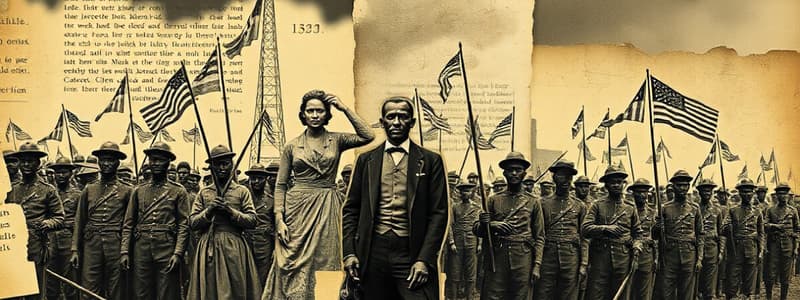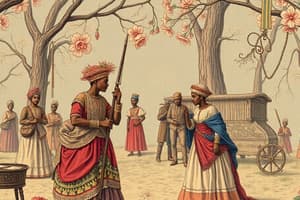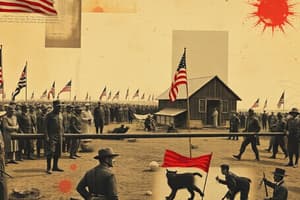Podcast
Questions and Answers
What event in April 1861 marked the beginning of the Civil War?
What event in April 1861 marked the beginning of the Civil War?
- The Crittenden Compromise
- The election of Abraham Lincoln
- The formation of the Confederate States of America
- The attack on Fort Sumter (correct)
Abraham Lincoln carried all states in the South during his election.
Abraham Lincoln carried all states in the South during his election.
False (B)
Which states first seceded from the Union, leading to the Civil War?
Which states first seceded from the Union, leading to the Civil War?
South Carolina and six other states that formed the Confederate States of America
Abraham Lincoln viewed secession as a rebellion that threatened the ______ of the Union.
Abraham Lincoln viewed secession as a rebellion that threatened the ______ of the Union.
Match the following states with their perspective on secession:
Match the following states with their perspective on secession:
What was the main outcome of the Missouri Compromise of 1820?
What was the main outcome of the Missouri Compromise of 1820?
The Compromise of 1850 allowed Texas to enter the Union as a free state.
The Compromise of 1850 allowed Texas to enter the Union as a free state.
What was the main purpose of the Fugitive Slave Act of 1850?
What was the main purpose of the Fugitive Slave Act of 1850?
The novel ________ by Harriet Beecher Stowe heightened abolitionist sentiment in the North.
The novel ________ by Harriet Beecher Stowe heightened abolitionist sentiment in the North.
What was a significant consequence of the Kansas-Nebraska Act of 1854?
What was a significant consequence of the Kansas-Nebraska Act of 1854?
The Republican Party was formed to support the expansion of slavery into new territories.
The Republican Party was formed to support the expansion of slavery into new territories.
Match the following events with their effects:
Match the following events with their effects:
What division within the Democratic Party contributed to the Republican victory in the 1860 presidential election?
What division within the Democratic Party contributed to the Republican victory in the 1860 presidential election?
What did the Missouri Compromise of 1820 establish?
What did the Missouri Compromise of 1820 establish?
The Fugitive Slave Act of 1850 was welcomed by Northern abolitionists.
The Fugitive Slave Act of 1850 was welcomed by Northern abolitionists.
What was a key result of the Kansas-Nebraska Act of 1854?
What was a key result of the Kansas-Nebraska Act of 1854?
The Compromise of 1850 admitted California as a __________ state.
The Compromise of 1850 admitted California as a __________ state.
Why did the Republicans successfully capture northern voters in the 1860 presidential election?
Why did the Republicans successfully capture northern voters in the 1860 presidential election?
Match the events with their outcomes:
Match the events with their outcomes:
Uncle Tom’s Cabin was a novel that defended the institution of slavery.
Uncle Tom’s Cabin was a novel that defended the institution of slavery.
What coalition did the formation of the Republican Party unite?
What coalition did the formation of the Republican Party unite?
Flashcards
South Carolina's Secession
South Carolina's Secession
The first state to secede from the Union after Lincoln's election, signaling the beginning of the secession crisis.
Crittenden Compromise
Crittenden Compromise
A last-ditch attempt to prevent the Civil War by offering concessions to the South, but ultimately failed to bridge the gap between North and South.
Fort Sumter
Fort Sumter
A federal fort in Charleston Harbor that became the trigger for the Civil War when Confederate forces attacked it after Lincoln aimed to resupply it.
Secession as States' Rights
Secession as States' Rights
Signup and view all the flashcards
Secession as Rebellion
Secession as Rebellion
Signup and view all the flashcards
Missouri Compromise (1820)
Missouri Compromise (1820)
Signup and view all the flashcards
Nullification Crisis (1832-33)
Nullification Crisis (1832-33)
Signup and view all the flashcards
Annexation of Texas (1845)
Annexation of Texas (1845)
Signup and view all the flashcards
Compromise of 1850
Compromise of 1850
Signup and view all the flashcards
Fugitive Slave Act (1850)
Fugitive Slave Act (1850)
Signup and view all the flashcards
Uncle Tom's Cabin (1852)
Uncle Tom's Cabin (1852)
Signup and view all the flashcards
Kansas-Nebraska Act (1854)
Kansas-Nebraska Act (1854)
Signup and view all the flashcards
Formation of the Republican Party (1854)
Formation of the Republican Party (1854)
Signup and view all the flashcards
States' Rights
States' Rights
Signup and view all the flashcards
Failed Compromise Efforts
Failed Compromise Efforts
Signup and view all the flashcards
The Economic and Political Divide
The Economic and Political Divide
Signup and view all the flashcards
Study Notes
Slavery Issue 1820-1850
- Missouri Compromise (1820): Established Missouri as a slave state, Maine as a free state, and the 36°30' line prohibited slavery north of this latitude in the Louisiana Territory.
- Nullification Crisis (1832-33): Disputes over states' rights, particularly South Carolina's opposition to federal tariffs, highlighted divisions about federal power versus state power, indirectly related to slavery.
- Annexation of Texas (1845): Texas joined the Union as a slave state, intensifying conflicts over slavery's expansion.
- Compromise of 1850: California entered as a free state; the Fugitive Slave Act was strengthened, demanding the return of runaway slaves; Utah and New Mexico utilized popular sovereignty to decide on slavery.
- Slave Trade Abolished in Washington D.C. (1850): A symbolic gesture against slavery, while permitting the practice in Southern states.
Sectional Division Widening 1850-1856
- Fugitive Slave Act (1850): Increased resistance in the North, as abolitionists opposed returning escaped slaves; fueled the Underground Railroad.
- Uncle Tom's Cabin (1852): Harriet Beecher Stowe's novel exposed harsh realities of slavery and strengthened abolitionist efforts.
- Kansas-Nebraska Act (1854): Repealed the Missouri Compromise and introduced popular sovereignty in Kansas and Nebraska, leading to violent conflicts (Bleeding Kansas).
- Formation of the Republican Party (1854): An anti-slavery coalition emerged, opposing slavery's extension to new territories, uniting northern Whigs, Free-Soilers, and abolitionists.
- Dred Scott Case (1857, Context): Early court decisions favored pro-slavery interpretations of the Constitution, increasing sectional division.
Republican Victory 1860 Election
- Democratic Party Split: Northern and Southern Democrats supported different candidates, splitting the party's vote. Northern Democrats supported Stephen Douglas and popular sovereignty, while Southern Democrats backed John C. Breckinridge and a pro-slavery agenda.
- Republican Platform: Opposing slavery's expansion, but not its elimination in existing states, appealed to northerners who favored free labor and infrastructure improvements.
- Lincoln's Leadership: Lincoln's moderate stance appealed to diverse groups in the North and West, and he won all free states.
- Sectional Divisions: Lincoln won all free states but was rejected in the South, demonstrating the growing rift between North and South -- he was not even included in some Southern ballots.
Civil War Beginning (April 1861)
- Secession Crisis: Following Lincoln's election, Southern states seceded and formed the Confederate States of America. South Carolina seceded in December 1860, followed by six other states by February 1861.
- Compromise Failures: Attempts at compromise, such as the Crittenden Compromise, failed to bridge the gap; Republicans rejected proposals attempting to extend slavery.
- Fort Sumter (April 1861): The decision to resupply Fort Sumter, a pivotal federal fort in Charleston Harbor, triggered a Confederate attack, initiating the Civil War.
- Conflicting Views on Sovereignty: The South viewed secession as a legitimate assertion of states' rights, while the North, under Lincoln, saw it as a rebellion threatening the Union's survival.
- Economic and Political Divide: Industrial North versus agrarian, slavery-dependent South exacerbated tensions; Southern fears of losing influence in federal politics pushed them toward war.
Studying That Suits You
Use AI to generate personalized quizzes and flashcards to suit your learning preferences.



